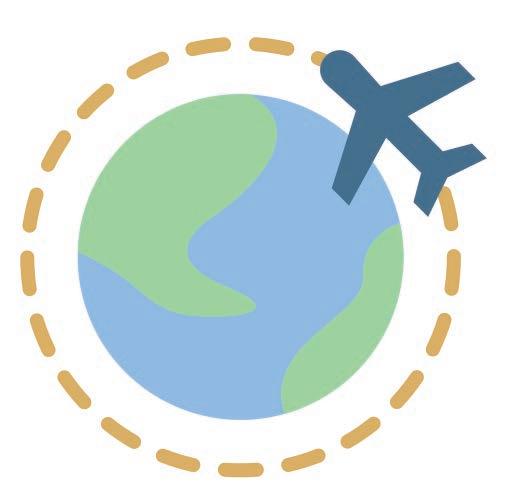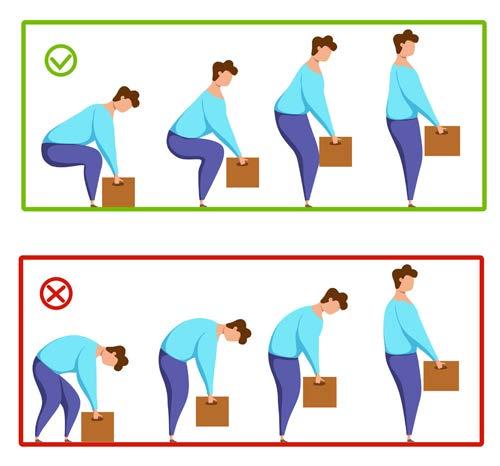
5 minute read
Travel Tips for a Pain Free Summer
Travel Tips For A Pain Free Summer
TEXT: JESSICA LOTT, DOCTOR OF PHYSICAL THERAPY IMAGES: WEB
As summer approaches, many people look forward to a much needed vacation, which usually involves traveling on and off the island. While traveling can be exciting and fun, it can also be compromising to our health.
Regardless of whether you are traveling by car, train, or airplane, traveling involves long periods of time standing and walking, sitting in tight and cramped spaces, and carrying and lifting heavy luggage. Additionally, traveling can have negative impacts on our bodies physiological functions. Lack of movement for sustained periods of time causes a decrease in blood flow to muscles and joints, digestion slows, muscles can become achy and spasm, and nerves can become compressed for too long causing damage. Prolonged sitting and standing causes fluid to accumulate in the lower legs and feet, resulting in edema. Decreased air pressure on airplanes causes a decrease in blood oxygen concentration. Lastly, low air humidity while flying results in dehydration and causes blood to thicken, which can lead to a serious condition called a deep vein thrombosis (DVT).
Luckily, there are simple ways you can prevent or minimize the negative effects of traveling so you can enjoy your trip.
1. Move Frequently
Limit sitting and standing to 1-2 hours at a time. Every hour is ideal, but this can sometimes be difficult to achieve. In between long bouts of sitting and standing, you should take a 5 minute break to move around. Get out of the car or your seat and walk around. You can also use this time to do gentle stretches and exercises.
2. Boost Blood Circulation
Simple exercises can be done both in sitting and standing to increase the blood circulation and help with avoiding a DVT. If you experience pain, tenderness, swelling, heat and/or redness in your legs, this may be a sign of a DVT or blood clot. Shortness of breath may be a sign that a clot has formed in your lungs or has moved there. If you suspect there is a problem, inform a crew member as soon as possible.
3. Stay Hydrated
Water comprises about 60% of our body, which means we require a lot of fluid during the day to maintain and prevent too much fluid loss. In addition to the decrease in air humidity on an airplane, we tend to drink less when we travel due to TSA liquid restrictions and less accessibility to restrooms. A general rule to follow for daily hydration is to drink half your bodyweight in ounces. For example, if you weigh 150 lbs, then you should drink at least 75 ounces of fluids per day. Signs of dehydration include feeling tired, urine is not clear or light yellow, and your eyes, skin, and or throat feel dry or itchy. Some tips to stay hydrated include:

Lift your feels up from floor while keeping the balls of your feet on the floor. Hold the pose for a few seconds at the top. Set your heels to the floor and ext lift up your toes. Hold for a few secondds. Repeat for 1 minute total.
Lift your feet off the floor. Trace circles whith your toes clockwise. Perform 30 seconds. Switch direction and draw circles conterclockwise for 30 seconds. Perform for 1 minute total.
Lift your foot off the floor, and straighten your leg as much as you can, while keeping your ankles bent and your toes pointed upward. Relax your leg. Repeat with the other lef. Perform each leg for 1 munute total.
Bend your lef and hug your knee as close to your chest as you can keep your back straight and hold the pose for a few seconds. Alternate each side a few times. Perform for 1 minute total.

•Carry an empty reusable water bottle with you.
• Avoid caffeine and alcoholic beverages as these increase dehydration.
• Drink coconut water instead of sugary sports drinks to replenish fluid and electrolytes.
4. Use Luggage Wisely
Pack heavier items in checked baggage and lighter items in carry-on bags. Make sure carry-on bags are comfortable to wear for long periods of time while standing in line and walking. Ideally, bags should have two straps and sit evenly across your shoulders. Use bags with roller wheels and luggage carts as much as possible to limit carrying. Use proper lifting techniques when picking up and lifting bags into overhead compartments such as:
• Keep luggage as close as possible to your body when lifting.
• Use your legs (not your back) by hinging your hips back prior to lifting.
• Keep your body facing the direction you are lifting, avoid twisting motions.
5. Maintain Regular Exercise Routines
Maintaining your activity level can help avoid aches and pains. Set yourself up for success to maintain your regular exercise routine when traveling by planning ahead. Research local exercise facilities and classes or incorporate physical activity into your trip when planning. Pack exercise clothes and shoes as well as portable workout equipment such as exercise bands and balls so you have what you need. Create a buddy system with someone, either in person or virtual, that can help keep you motivated and hold you accountable. Utilizing these tips should help ensure your summer travel experience is a positive one!
Jessica Lott is a Doctor of Physical Therapy, living in Taipei since 2021. She is from the United States and has been living and working in Asia since 2014. Prior to living in Taiwan, she lived in Shanghai, China where she worked as a Physical Therapist at Shanghai United Family Hospital and UP Clinic. Jessica has experience treating various conditions and injuries and works with individuals of all ages. She is passionate about physical health, wellness, and helping people achieve their goals. You can contact Jessica at physicalrestorations@gmail.com










